I’m kind of old for the number of years I have in education—it’s my third and final career. You’d think a teacher who is entering her eleventh year would be early to mid-thirties (I wish)! I won’t reveal how old I am (many years ago I cancelled my birthday due to a general lack of interest—I try hard to forget how old I am), but I will admit during my senior year I took the very first computer class held at MVHS. I learned how to use DOS to program a tic-tac-toe game on an Apple Computer. Quite cutting edge at the time. Before that first computer class, I learned—as did most everyone in high schools across the country—my keyboarding skills on an IBM Selectric typewriter.
Not long ago our media specialist drew a crowd to her desk when she used a similar typewriter to type a book label. Several kids asked, “what’s that?” It was funny and disheartening—how could they not know what that machine was already? How our world has changed in (what seems to me) just a few years.
In my classroom I alternate between thanking the heavens above for the addition of technology to teac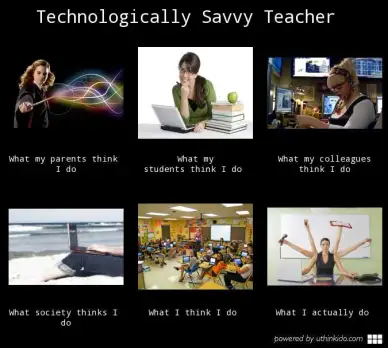 hing and cursing my reliance on technology because my projector is suddenly on strike—always when I’ve neglected to prepare a Plan B. I must not be alone in my split feelings since I’ve seen meme after meme expressing similar feelings. Do a Google Image search—there are lots of them!
hing and cursing my reliance on technology because my projector is suddenly on strike—always when I’ve neglected to prepare a Plan B. I must not be alone in my split feelings since I’ve seen meme after meme expressing similar feelings. Do a Google Image search—there are lots of them!
Sitting in my computer class XX years ago (no those are not the Roman numerals for twenty—just placeholders), I would never have imagined that A) I’d be a teacher B) I’d be teaching in that very building someday C) a computer would be central to 75% of my teaching day helping me do things like project information and activities onto the screen for instructional purposes and maintain my grade books or communicate with colleagues and parents.
No more erasing and rewriting parts of a lesson on the board for each class during the day, no more messy overhead projector markers, and no more writing grades down by hand in a grade book and manually calculating the scores to figure out whether or not a student is passing. I teach English partly because Math and I have personality conflicts. I’m working to become friends someday, but it hasn’t happened yet.
As a high school kid, I dreaded the day we graded assignments in class and called out our scores for everyone to hear. Maybe calling out 83 or 88 wasn’t a bad thing (I was always Queen of the B’s), but after W. Abbott just called out 95 or 99, P. Bearnson always felt dumb. I suppose some teachers might still do that even with the assistance of a computer, but the addition of a computer has made that experience something I don’t ask of my students; it’s just too public, especially for shy or struggling students—I might not have struggled, but I was very, very shy.
Although I might find it important to respect my students’ in-class privacy, the word privacy does not hold the same meaning in our technologically connected world as it did XX years ago. Twitter, Facebook, Instagram, Spotify, Linkedin, Reddit, Youtube, Flickr, Tumblr, Yik Yak and hundreds of other social networking sites link us toget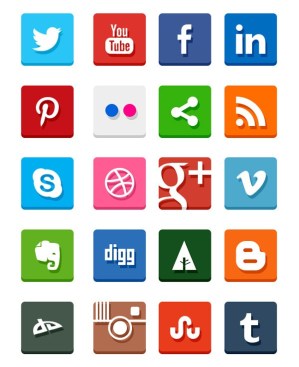 her. Sometimes we are linked whether we want to be or not.
her. Sometimes we are linked whether we want to be or not.
The addition of social media to the culture of a school has brought a mixed bag—helps and heartaches. Class blogs and school Facebook pages can certainly be welcome tools when set-up and used correctly, but they can also be tools for rumormongers and bullies. In the education world, social media has added one more thing to our long list of Things-To-Teach—Digital Citizenship.
Even the meanest bully knows how to be pleasant to his or her prey when in the presence of a teacher or adult, but too often, the sweetest child can become a beast through the seemingly safe distance provided by a social media site. Digital smarts are not inherent in children—or adults for that matter.
This week while attending an orientation class for a yearlong, statewide training, our instructor stopped the very intense conversation we were having about our class assignments and responsibilities to discuss what it means to be a good digital citizen. A room full of professionals and still the subject had to be discussed because there had been problems in the past.
If we as adults and professionals who are experienced as citizens in both the face-to-face and digital world had to be reminded how a good citizen acts on-line, how much more important is it for us to make sure to include expectations when providing learning opportunities for our students involving social media. We must be a physical and alert presence in their educational social media world. Should we also invite parents and administrators into these social media opportunities to provide another level of transparency?
Even though we must be a presence in the educational social media worlds we ask our students to step into, the role educators play in non-educational social media world that involve our students is murky and treacherous. Is it ever appropriate to be social with students outside of school? In the face-to-face world, we might chat with a student if we ran into them at the grocery store, but would we feel comfortable going with a student to a movie or a party? Would they really be comfortable having us there?
My niece, Lou, was one of my Fantasy Lit. students a few years ago, plus the poor kid had to live with me too—nearly everywhere she went there was her Aunt P. To break up the monotony of a school week, a colleague—Lou’s English teacher—invited me to go to the movie and when I mentioned it was one my niece wanted to see she suggested I bring her too (I brought my mother too—family outing!). As we sat waiting for the movie to start, my niece took a selfie with all of us in the background. She sent it in a text to her mother and a friend back in her hometown with the tagline, “Awkward! At the movie with two of my English teachers. Weird.” I don’t think she really felt awkward at the movie with us, but the idea of being at the movie with your teachers caused her to realize how others would feel in that situation.
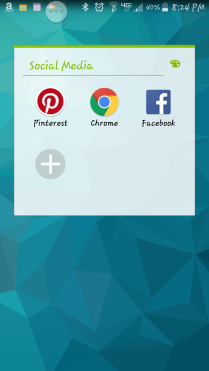
As the social media file on my cellphone attests, my social network site of choice is Facebook. (That might tell my age right there!) Some kids feel it is awkward to be friends on Facebook with a teacher, but others feel it is completely normal. Generally, I don’t socialize with students on-line; as a matter of fact, I deleted two student friend requests just this week. I do have a few exceptions caused by my longtime relationship with people in my community whose children I’ve known since they were small. My on-line social networking rule: If I socialize with your parents through social media and I’ve accepted you as a friend before becoming my student, I won’t delete you. So far, it hasn’t been a problem. I only had two students last year who were linked to me directly through social media (not including my niece—another one—poor girls).
Since my district does not have an official policy regarding social media, I’m willing to take small risks with on-line social media and my students (I do give both students and their parents my cell phone number and I will text about assignments—they’ve always been respectful of that trust so far), but overall I’m not comfortable being their friend. I don’t want them to have access to the goofy sleeping-on-the-bus picture my friend took of me in Europe last summer, but mostly I feel uncomfortable being their friend because I’m not their friend; I’m their teacher.
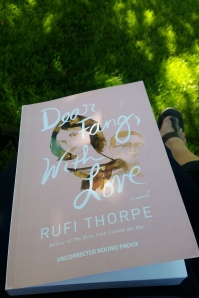 lle and I left town that day, we all opened our packages. I was not quite sure what to think of my book. Dear Fang, With Love. Even without the brown paper, I had very little evidence to suggest what I might find behind the salmon cover. The uncorrected softbound proof had nothing on the back to hint at whether on not it was a vampire or dog book. Since I was in the middle of my master’s paper, I knew it would be awhile before I would peel back that pink cover.
lle and I left town that day, we all opened our packages. I was not quite sure what to think of my book. Dear Fang, With Love. Even without the brown paper, I had very little evidence to suggest what I might find behind the salmon cover. The uncorrected softbound proof had nothing on the back to hint at whether on not it was a vampire or dog book. Since I was in the middle of my master’s paper, I knew it would be awhile before I would peel back that pink cover.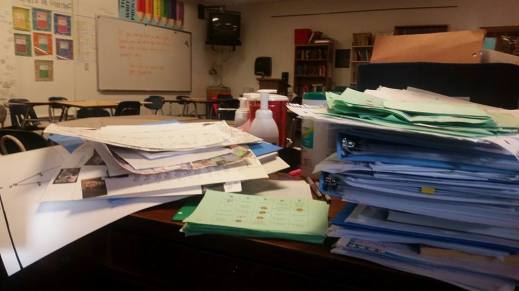 y papers! So much time spent grading. Are you sure? Don’t you remember how big the to-be-graded pile was on my desk at the end of the trimester?”
y papers! So much time spent grading. Are you sure? Don’t you remember how big the to-be-graded pile was on my desk at the end of the trimester?” 
 hing and cursing my reliance on technology because my projector is suddenly on strike—always when I’ve neglected to prepare a Plan B. I must not be alone in my split feelings since I’ve seen meme after meme expressing similar feelings. Do a Google Image search—there are lots of them!
hing and cursing my reliance on technology because my projector is suddenly on strike—always when I’ve neglected to prepare a Plan B. I must not be alone in my split feelings since I’ve seen meme after meme expressing similar feelings. Do a Google Image search—there are lots of them!
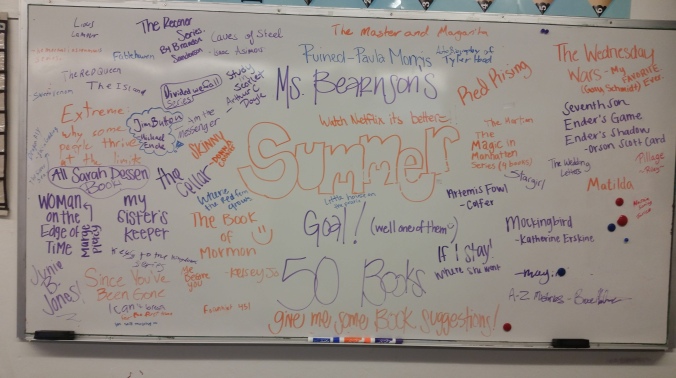
 t deal of experience with fantasy literature (beyond fairy tales), and Card’s book didn’t hold my attention beyond the first few chapters. Truthfully, I was probably lured away by a new Kathleen Woodiwiss or Janet Dailey romance novel which was my genre of choice at that time. Last year, based on the ravings of several students, I gave another of Card’s books,
t deal of experience with fantasy literature (beyond fairy tales), and Card’s book didn’t hold my attention beyond the first few chapters. Truthfully, I was probably lured away by a new Kathleen Woodiwiss or Janet Dailey romance novel which was my genre of choice at that time. Last year, based on the ravings of several students, I gave another of Card’s books,